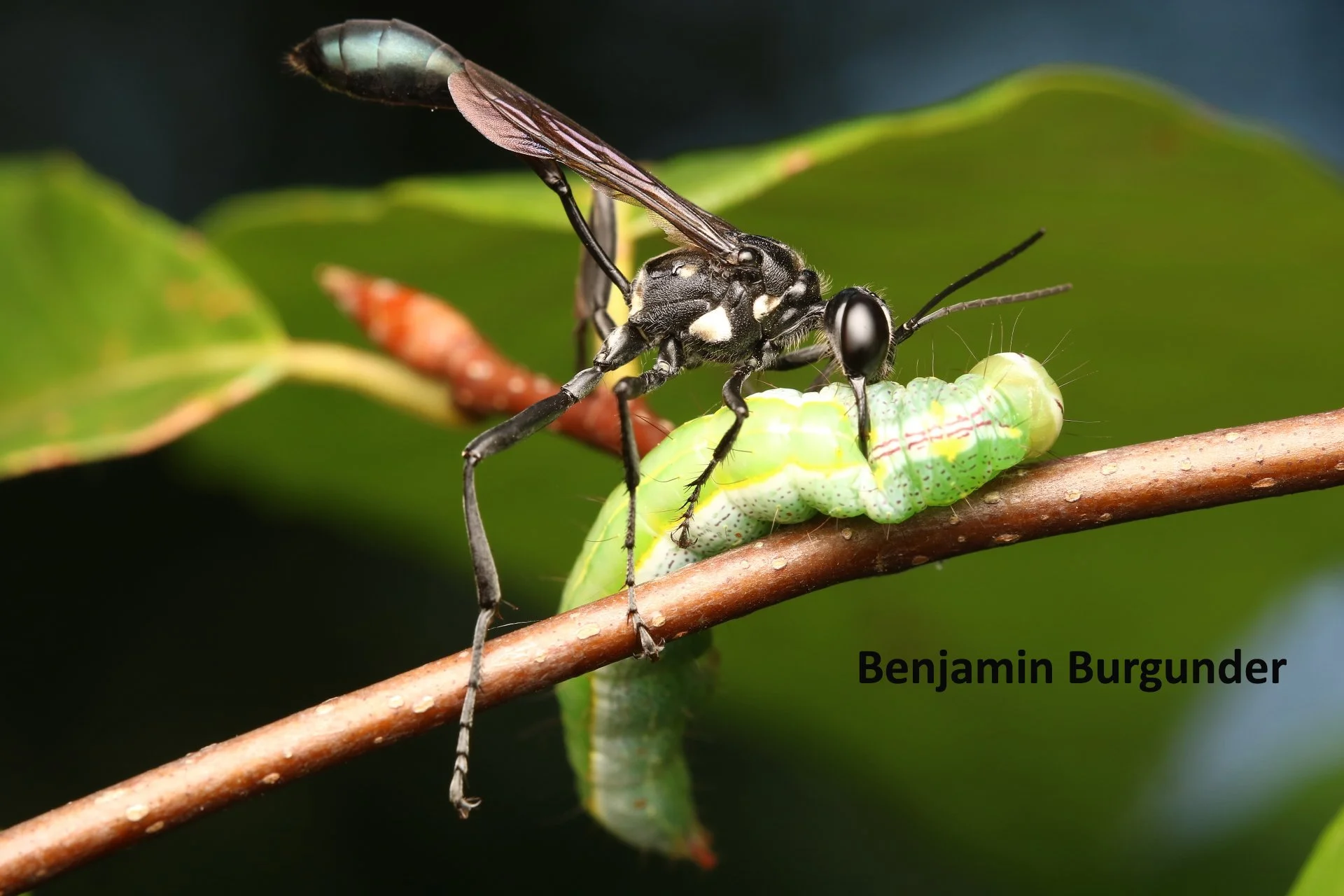Spotted horsemint rocks with pollinators on late summer and early autumn days.
One of my favorite late summer and early autumn bloomers is spotted horse mint, Monarda punctata. During this season horsemint attracts an amazing variety of pollinators, including several species of remarkable wasps including great black wasps, mason wasps, and potter wasps. Among the most interesting and beautiful of these visitors are thread-waisted wasps in the family Sphecidae. One of the most common members of the sphecid clan visiting horsemint is Eremnophila aureonotata, hunter of caterpillars. Caterpillars serve as food for her larvae. Locating and subduing caterpillars requires loads of energy, and frequent trips to flowers for carbohydrate-rich nectar are regular daily activities. When not feeding on flowers, Eremnophila search foliage to find caterpillars, the food for their young. Upon finding a potential victim such as a prominent caterpillar, the female wasp wrestles with the larva and delivers a paralyzing sting. The immobilized victim is then transported to a subterranean nursery and placed beneath the ground. An egg deposited on the hapless victim hatches into a legless larva that consumes the living but powerless prey. Before leaving her young, the mother carefully arranges debris, pebbles, and dirt over the burrow to disguise the entry to her nest. This probably keeps other insects from making a meal of her young or their provisions of caterpillars.
Caterpillars stung and paralyzed by female thread-waisted wasps will become fresh meat for the wasp youngsters as they develop underground. Eremnophila aureonotata in Anne Arundel Co., Maryland (8/24/2024). Image: Benjamin Burgunder, some rights reserved (CC BY).
Mating behaviors of Eremnophila include prolonged coupling of the blissful pair with the male grasping his mate by the neck as she saunters from blossom to blossom. This prolonged tandem linkage likely ensures that the sperm of the lucky suitor will be the ones that fertilize eggs carried by his mate, sort of a behavioral guarantee of paternity. This prolonged copulatory guarding is seen in many other species of insects, such as dragonflies and damselflies. In addition to spotted horsemint, thread-waisted wasps frequent goldenrods and other members of the aster family. When your late summer and early autumn rambles take you to the meadow, try to catch a glimpse of these clever hunters as they fly in tandem amongst the blossoms.
Spotted horse mint is a dynamite attractor of many kinds of pollinators. Watch as this female thread-waisted wasp searches blossoms for carbohydrate-rich nectar. Nectar powers her mission to find caterpillars that will be stung, paralyzed, and consumed by her offspring as they develop in subterranean galleries. Her piggy-backing mate isn’t just there for the ride. Prolonged copulation ensures that his sperm will be the ones to fertilize eggs of his mate, a behavioral insurance policy of paternity. But I wonder, does he really have to grab her by the neck?
Acknowledgements
Interesting and entertaining accounts of thread-waisted wasps including “The habits of aculeate Hymenoptera” by William Ashmead, “Sleep in insects: An ecological study” by Phil and Nellie Ray, “Insects: Their natural history and diversity” by Stephen Marshall, and “Predatory Wasps (Hymenoptera) of the Yucatan Peninsula” by Maximiliano Vanoye-Eligio, Virginia Meléndez Ramírez, Ricardo Ayala, Jorge Navarro and Hugo Delfin-González, were used as references for this episode. With thanks to Ben Burgunder for generously allowing use of his fine image of a thread-waisted wasp capturing a caterpillar.
